Toyota RAV4: Adjustable components (seats, mirrors, steering wheel)
Front seats
Manual seat
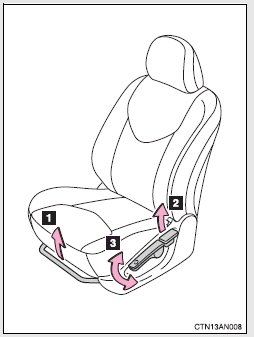
1 Seat position adjustment
lever
2 Seatback angle adjustment
lever
3 Vertical height adjustment
lever (driver’s side only)
Power seat (driver’s side only)
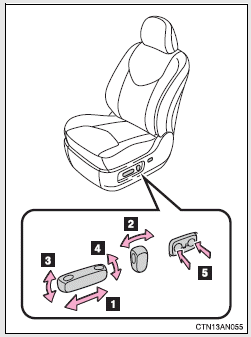
1 Seat position adjustment
switch
2 Seatback angle adjustment
switch
3 Seat cushion (front) angle
adjustment switch
4 Vertical height adjustment
switch
5 Seat lumbar support adjustment
switch
Flattening front seatbacks
The front seats can be moved into a flat seat arrangement.
Manual seat
1 Slide the second seats as far back as possible.
2 Remove the front head restraint.
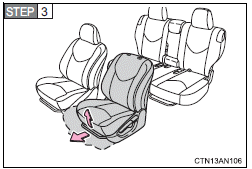
Slide the front seat further forward than the front-most lock position.
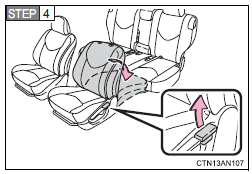
Pull the seatback angle adjustment lever up to unlock and push down the seatback. After returning the seat to its original position, be certain to replace the head restraint.
Power seat
1 Slide the second seats as far back as possible.
2 Remove the front head restraint.
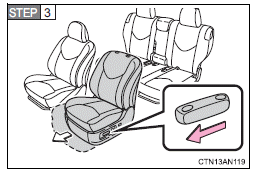
Push the seat position adjusting switch forward to slide the seat to the front-most position.
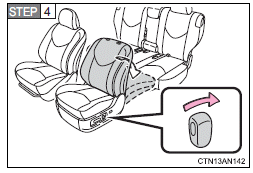
Move the seatback angle adjusting switch backward to flatten the seatback. After returning the seat to its original position, be certain to replace the head restraint.
Active head restraints
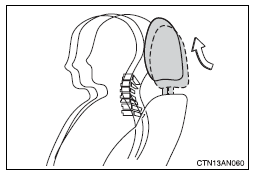
When the occupant’s lower back presses against the seatback during a rear-end collision, the head restraint moves slightly forward and upward to help reduce the risk of whiplash on the seat occupant.
■Active head restraints
Even small forces applied to the seatback may cause the head restraint to move. Pushing up a locked head restraint forcibly may appear the head restraint inner structure. These do not indicate problems.
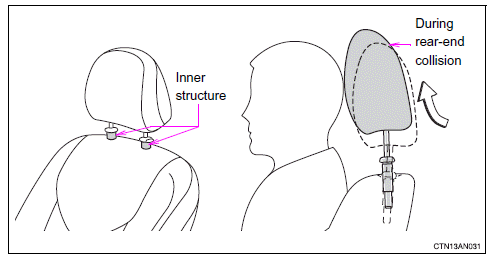
CAUTION
■Seat adjustment
●Be careful that the seat does not hit passengers or luggage.
●Do not recline the seat more than necessary when the vehicle is in motion
to reduce the risk of sliding under the lap belt.
If the seat is too reclined, the lap belt may slide past the hips and apply
restraint forces directly to the abdomen or your neck may contact the
shoulder belt, increasing the risk of death or serious injury in the event of
an accident.
●Manual seat only: After adjusting the seat, make sure that the seat is
locked in position.
Rear seats
■ Second seats
Vehicles with third seat
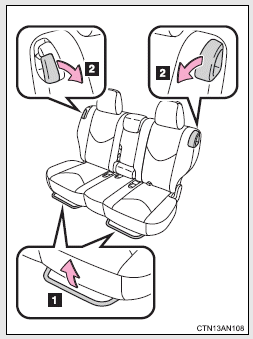
1 Seat position adjustment
levers
2 Seatback angle adjustment
levers
When a person sits in the rear center position, adjust both seat cushions to the same position and align all seatbacks at the same angle.
Vehicles without third seat
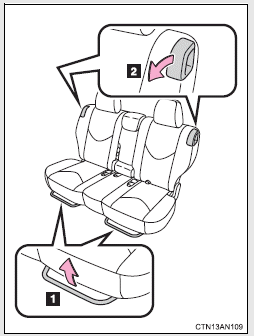
1 Seat position adjustment
levers
2 Seatback angle adjustment
levers
When a person sits in the rear center position, adjust both seat cushions to the same position and align all seatbacks at the same angle.
■ Third seats (if equipped)
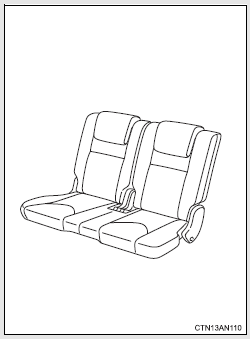
The third seats do not have a seat adjustment function.
Moving a second seats for third seats entry (vehicles with third seats)
■ Getting in the vehicle (right side only)
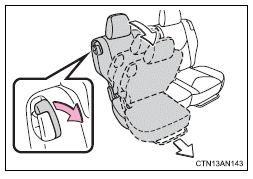
Pull the lever forward and fold down the seatback. The seat will slide forward. After passengers are in, lift up the seatback and return the seat to the original position.
Folding second seats
Folding down the second seats will enlarge the luggage compartment.
■ Before folding the second seats
1 Stow the second center seat belt.

Make sure the outside seat belt passes through the hanger when folding the second seat. This prevents the shoulder belt from being damaged.

Stow the second seat belt buckles.
4 Remove the outside head restraint
5 Lower the center head restraint to the lowest position.
6 Raise the armrest until it locks.
■ Folding second seats
1 Slide the second seats as far back as possible
From inside
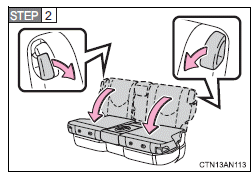
Pull down the seatback angle adjustment lever and fold down the seatback.
From outside (vehicles without third seats)
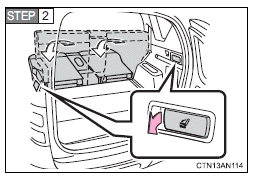
Open the back door and pull the lock release lever to fold down the second seat.
Stowing third seats (vehicles with third seats)
■ Before stowing the third seats
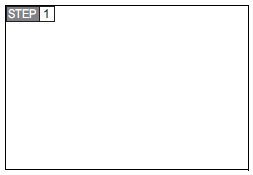
Stow the third seat belt buckles.
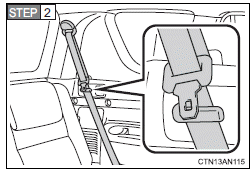
Pass the seat belts through the seat belt hangers. This prevents the shoulder belt from being damaged.
3 Lower the head restraint to the lowest position
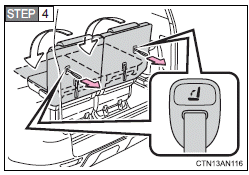
Pull the seatback lock release strap to fold down the seatback. Make sure it is locked securely.
■ Stowing third seats
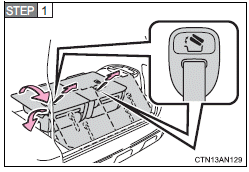
Pull and hold the seat lock release strap and lift up the seat rearward and then push the seat down.
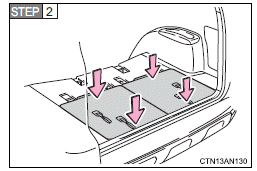
Push the seat on the front side against the floor and push the seat on rear side against the floor. Make sure it is locked securely.
■ Returning third seats
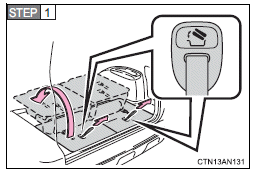
Pull the seat lock release strap, lift the seat up and move the seat forward. Lock the seat into place. Make sure it is locked securely.
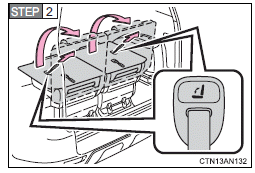
Pull the seatback lock release strap and raise the seatback. If the seat does not lift up when the seat lock release strap is pulled, lock the seatback again.
CAUTION
■Seat adjustment
Observe the following precautions.
Failure to do so may result in death or serious injuries.
●The seat belts provide maximum protection in a frontal or rear collision
when the driver and the front passenger are sitting up straight and well
back in the seats.
If you recline the seatback more than necessary, the lap belt may slide
past your hips and apply restraint forces directly to the abdomen or your
neck may contact the shoulder belt.
●Be careful not to get your hands or feet pinched in the seat.
●Do not adjust the seat while the vehicle is moving as the seat may unexpectedly
move and cause the driver to lose control of the vehicle.
●Be careful that the seat does not hit a passenger or luggage.
●Do not put objects under the seats.
Otherwise, the objects may interfere with the seat-lock mechanism or
unexpectedly push up the seat position adjustment lever and the seat may
suddenly move, causing the driver to lose control of the vehicle.
●Adjust both seat cushions to the same position and align all seatbacks at
the same angle when a person sits in the rear center position.
Otherwise, the person cannot wear the seat belt properly and this may
cause death or serious injuries in a collision.
CAUTION
■When folding second seats
●Stop the vehicle on level ground, set the parking brake and shift the shift
lever to P.
●Do not fold the second seatback when passengers sit or luggage is placed
on the seat.
●Do not allow passengers to ride on the folded seat or in the luggage
compartment
while driving.
●Make sure that no passengers or luggage are on the rear seats.
●Make sure the seatback is securely locked by pushing forward and rearward
on the top of the seatback.
Failure to do so will prevent the seat belt from operating properly.
■When stowing third seats
●Make sure that no passenger or luggage are on the seats. Then, hold the
seat and slowly move it.
Otherwise, people may be injured or luggage may be damaged if the seat
hits them.
●Make sure the seat is securely locked by pushing forward and rearward on
the top of the seatback or by trying to pull up the edge of the bottom cushion.
Failure to do so will prevent the seat belt from operating properly.
●Make sure the seat belts are not twisted or caught in the seatback and are
arranged in their proper position ready for use.
●Do not stow or return the seats when you are inside the vehicle in order to
prevent pinching your hands or feet in the seat.
Be sure to stow and return the seats from outside the vehicle.
CAUTION
■After adjusting a seat
●After adjusting the seat position, try sliding it forward and backward to
make sure it is locked in position.
●After adjusting the seatback, push your body adjust the seatback to make
sure it is locked in position.
●Make sure the seat belts are not twisted or caught in the seatback and are
arranged in their proper position and are ready for use.
NOTICE
■Before folding the seats
To prevent damage to the seat belt buckles, stow them before folding the
seatback.
Head restraints
Head restraints are provided for all seats.
Front seats
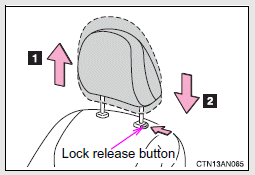
1 Up
Pull the head restraints up.
2 Down
Push the head restraint down
while pushing the lock release
button.
Second seats

1 Up
Pull the head restraints up.
2 Down
Push the head restraint down
while pushing the lock release
button.
Third seats (if equipped)
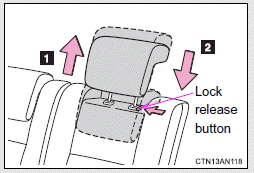
1 Up
Pull the head restraints up.
2 Down
Push the head restraint down
while pushing the lock release
button.
■Removing the head restraints
Front seats
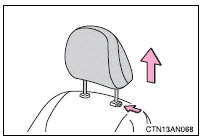
Pull the head restraint up while pushing the lock release button.
Second seats
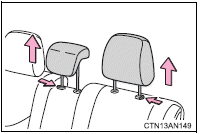
Pull the head restraint up while pushing the lock release button.
Third seats (if equipped)
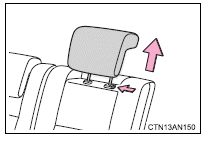
Pull the head restraint up while pushing the lock release button.
■Installing the head restraints
Front seats
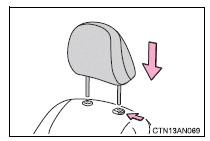
Align the head restraint with the installation holes and push it down while pressing the lock release button.
Second seats
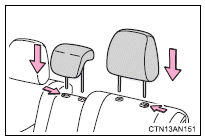
Align the head restraint with the installation holes and push it down while pressing the lock release button.
Third seats (if equipped)

Align the head restraint with the installation holes and push it down while pressing the lock release button.
■Adjusting the height of the head restraints
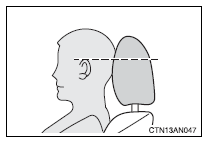
Make sure that the head restraints are adjusted so that the center of the head restraint is closest to the top of your ears.
■Adjusting the rear seat head restraints (except second outside head restraints)
Always raise the head restraint one level from the stowed position when using.
CAUTION
■Head restraint precautions
Observe the following precautions regarding the head restraints. Failure to
do so may result in death or serious injury.
●Use the head restraints designed for each respective seat.
●Adjust the head restraints to the correct position at all times.
●After adjusting the head restraints, push down on them and make sure
they are locked in position.
●Do not drive with the head restraints removed.
Seat belts
Make sure that all occupants are wearing their seat belts before driving the vehicle.
■ Correct use of the seat belts
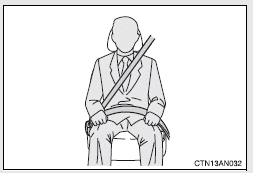
● Extend the shoulder belt so
that it comes fully over the
shoulder, but does not
come into contact with the
neck or slide off the shoulder.
● Position the lap belt as low
as possible over the hips.
● Adjust the position of the
seatback. Sit up straight
and well back in the seat.
● Do not twist the seat belt.
■ Fastening and releasing the seat belt
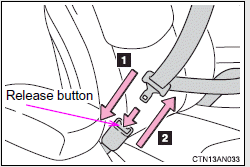
1 Fastening the belt
Push the tab into the buckle
until a clicking sound is heard.
2 Releasing the belt
Press the release button.
■ Adjusting the height of the belt (front seats)
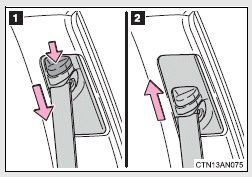
1 Down
2 Up
Move the height adjuster up
and down as needed until you
hear a click.
Second center seat belt
The second center seat belt is a 3-point type restraint with 2 buckles. Both seat belt buckles must be correctly located and securely latched for proper operation.
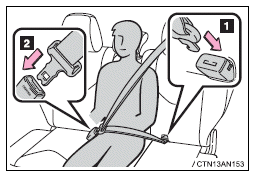
Make sure that the buckle 1 is
securely latched ready for use of
the center seat belt.
1 Tab “A”
2 Tab “B”
■ Releasing method
The second center seat belt can be completely released only when necessary such as when folding down the second seats.

To release the tab “A”, insert the tab “B”, key (vehicles without a smart key system) or mechanical key (vehicles with a smart key system) into the hole on the buckle. Retract the belt slowly when releasing and stowing the seat belt.
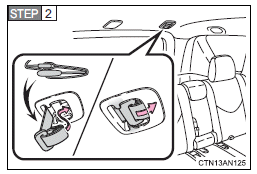
Stow the seat belt tabs in the cover located on the roof as shown.
Seat belt pretensioners (front seats)
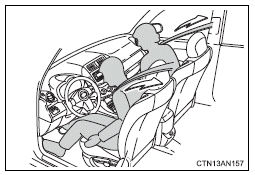
The pretensioner helps the seat belt to quickly restrain the occupant by retracting the seat belt when the vehicle is subjected to certain types of severe frontal collision or a vehicle rollover. The pretensioner may not activate in the event of a minor frontal impact, a side impact or a rear impact.
■Emergency locking retractor (ELR)
The retractor will lock the belt during a sudden stop or on impact. It may also lock if you lean forward too quickly. A slow, easy motion will allow the belt to extend so that you can move around fully.
■Automatic locking retractor (ALR)
When a passenger's shoulder belt is completely extended and then retracted even slightly, the belt is locked in that position and cannot be extended. This feature is used to hold the child restraint system (CRS) firmly. To free the belt again, fully retract the belt and then pull the belt out once more.
■Pregnant women

Obtain medical advice and wear the seat belt in the proper way.
Women who are pregnant should position the lap belt as low as possible over the hips in the same manner as other occupants. Extend the shoulder belt completely over the shoulder and position the belt across the chest. Avoid belt contact over the rounding of the abdominal area. If the seat belt is not worn properly, not only a pregnant woman, but also the fetus could suffer death or serious injury as a result of sudden braking or a collision.
■People suffering illness
Obtain medical advice and wear the seat belt in the proper way.
■When not using the outer rear seat belts
Second seats
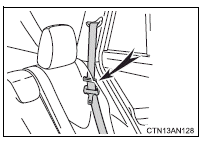
Pass the outer rear seat belts through the seat belt hangers and secure the seat belt plates to prevent the shoulder belts from being damaged.
Third seats

Pass the seat belts through the seat belt hangers to prevent the shoulder belts from being damaged.
■Child seat belt usage
The seat belts of your vehicle were principally designed for persons of adult size.
●Use a child restraint system appropriate for the child, until the child
becomes large enough to properly wear the vehicle's seat belt.
●When the child becomes large enough to properly wear the vehicle's seat
belt. 2 regarding seat belt usage.
■Replacing the belt after the pretensioner has been activated
If the vehicle is involved in multiple collisions, the pretensioner will activate for the first collision, but will not activate for the second or subsequent collisions.
■Seat belt extender
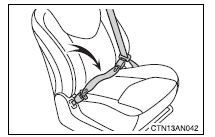
If your seat belts cannot be fastened securely because they are not long enough, a personalized seat belt extender is available from your Toyota dealer free of charge.
CAUTION
Observe the following precautions to reduce the risk of injury in the event of
sudden braking, sudden swerving or an accident.
Failure to do so may cause death or serious injury.
■Wearing a seat belt
●Ensure that all passengers wear a seat belt.
●Always wear a seat belt properly.
●Each seat belt should be used by one person only. Do not use a seat belt
for more than one person at once, including children.
●Toyota recommends that children be seated in the rear seat and always
use a seat belt and/or an appropriate child restraint system.
●Do not recline the seat any more than necessary to achieve a proper seating
position. The seat belt is most effective when the occupants are sitting
up straight and well back in the seats.
●Do not wear the shoulder belt under your arm.
●Always wear your seat belt low and snug across your hips.
■When children are in the vehicle
Do not allow children to play with the seat belt. If the seat belt becomes
twisted around a child’s neck, it may lead to choking or other serious injuries
that could result in death.
If this occurs and the buckle cannot be unfastened, scissors should be used
to cut the belt.
CAUTION
■Adjustable shoulder anchor
Always make sure the shoulder belt is positioned across the center of your
shoulder. The belt should be kept away from your neck, but not falling off
your shoulder. Failure to do so could reduce the amount of protection in an
accident and cause death or serious injuries in the event of a sudden stop,
sudden swerve or accident.
■Seat belt pretensioners
●Do not place anything, such as a cushion, on the front passenger's seat.
Doing so will disperse the passenger's weight, which prevents the sensor
from detecting the passenger's weight properly. As a result, the seat belt
pretensioner for the front passenger's seat may not activate in the event of
a collision.
●If the pretensioner has activated, the SRS warning light will come on. In
that case, the seat belt cannot be used again and must be replaced at
your Toyota dealer.
■Seat belt damage and wear
●Do not damage the seat belts by allowing the belt, plate, or buckle to be
jammed in the door.
●Inspect the seat belt system periodically. Check for cuts, fraying, and loose
parts. Do not use a damaged seat belt until it is replaced. Damaged seat
belt cannot protect an occupant from death or serious injury.
●Ensure that the belt and tab are locked and the belt is not twisted.
If the seat belt does not function correctly, immediately contact your Toyota
dealer.
●Replace the seat assembly, including the belts, if your vehicle has been
involved in a serious accident, even if there is no obvious damage.
●Do not attempt to install, remove, modify, disassemble or dispose of the
seat belts. Have any necessary repairs carried out by your Toyota dealer.
Inappropriate handling of the pretensioner may prevent it from operating
properly resulting in death or serious injury.
CAUTION
■When using the second center seat belt
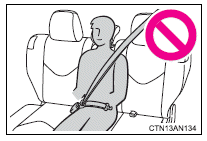
■Using a seat belt extender
●Do not wear the seat belt extender if you can fasten the seat belt without
the extender.
●Do not use the seat belt extender when installing a child restraint system
because the belt will not securely hold the child restraint system, increasing
the risk of death or serious injury in the event of an accident.
●The personalized extender may not be safe on another vehicle, when
used by another person, or at a different seating position other than the
one originally intended.
NOTICE
■When using a seat belt extender
When releasing the seat belt, press on the buckle release button on the
extender, not on the seat belt.
This helps prevent damage to the vehicle interior and the extender itself.
Steering wheel
The steering wheel can be adjusted to a comfortable position.
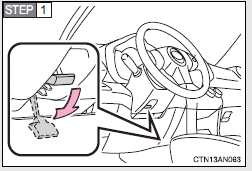
Hold the steering wheel and press the lever down.
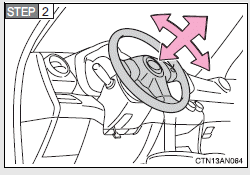
Adjust to the ideal position by moving the steering wheel horizontally and vertically. After adjustment, pull the lever up to secure the steering wheel.
CAUTION
■Caution while driving
Do not adjust the steering wheel while driving.
Doing so may cause the driver to mishandle the vehicle and an accident,
resulting in death or serious injury.
■After adjusting the steering wheel
Make sure that the steering wheel is securely locked.
Otherwise, the steering wheel may move suddenly, possibly causing an
accident and resulting in death or serious injury.
Anti-glare inside rear view mirror
Glare from the headlights of vehicles behind can be reduced by using the following functions.
Manual anti-glare inside rear view mirror
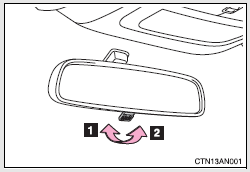
1 Normal position
2 Anti-glare position
Auto anti-glare inside rear view mirror
In automatic mode, sensors are used to detect the headlights of vehicles behind and the reflected light is automatically reduced.

Turns automatic mode on/off
The indicator comes on when automatic mode is turned ON. Vehicles without smart key system:
The mirror will revert to the automatic mode each time the engine switch is turned to the “ON” position. Vehicles with smart key system:
The mirror will revert to the automatic mode each time the “ENGINE START STOP” switch is turned to IGNITION ON mode.
Adjusting the height of rear view mirror
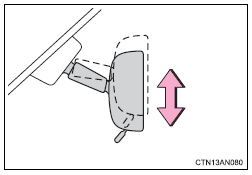
Adjust the height of the rear view mirror by moving it up and down.
■To prevent sensor error (vehicles with auto anti-glare inside rear view mirror)
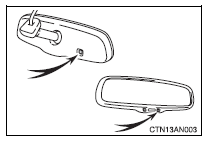
To ensure that the sensors operate properly, do not touch or cover them.
CAUTION
■Caution while driving
Do not adjust the position of the mirror while driving.
Doing so may lead to mishandling of the vehicle and an accident, resulting in
death or serious injury.
Outside rear view mirrors
Vehicles without smart key system
Mirror angle can be adjusted using the switch when the engine switch is in the “ACC” or “ON” position.
Vehicles with smart key system
Mirror angle can be adjusted using the switch when the “ENGINE START STOP” switch is in ACCESSORY or IGNITION ON mode.
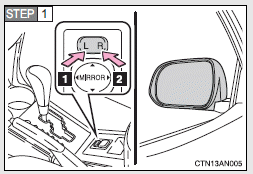
Select a mirror to adjust.
1 Left
2 Right

Adjust the mirror.
1 Up
2 Right
3 Down
4 Left
Folding back the mirrors
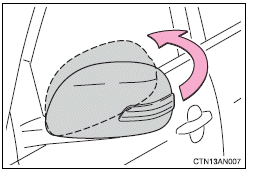
Push backward to fold the mirrors.
■When the mirrors are fogged up (vehicles with outside rear view mirror defoggers)
Turn on the mirror defoggers to defog the mirrors.
CAUTION
■When driving the vehicle
Observe the following precautions while driving.
Failing to do so may result in loss of control of the vehicle and cause an
accident,
resulting in death or serious injury.
●Do not adjust the mirrors while driving.
●Do not drive with the mirrors folded back.
●Both the driver and passenger side mirrors must be extended and properly
adjusted before driving.
■When the mirror defoggers are operating (vehicles with outside rear
view mirror defoggers)
Do not touch the rear view mirror surfaces, as they can become very hot and
burn you.
See also:
Audio system
Antenna Roof type antenna If your vehicle has an audio system, an amplifying
antenna is installed in your vehicle. This antenna can be removed from the vehicle
when you wash your vehicle.
NOTICE • Be sure to remove the antenna before washing ...
Department of transportation uniform tire quality grades
The following tire grading categories were established by
the National Highway Traffic Safety Administration. The
specific grade rating assigned by the tire’s manufacturer
in each category is shown on the sidewall of the tires on
your vehic ...

 Opening, closing and locking the doors
Opening, closing and locking the doors